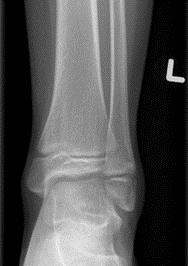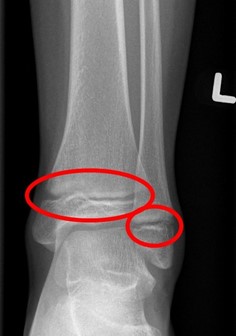
 POSNA.org
POSNA.org
Low-energy lateral ankle injuries often occur after a child/athlete “twists” or “rolls” his/her ankle. This can be due to misplaced footing or slipping on uneven ground or off a piece of sports equipment. Children with these injuries have X-rays that may not show clear signs of a fracture (break of the bone). Low-energy ankle injuries are different from higher-energy injuries such as those that occur after falls from a height, a significant impact or collision, or involving a moving vehicle. 

Low-energy injuries to the ankle are common in children and adolescents. Most heal in a predictable way with appropriate support and time. Many injuries are referred to as “sprains” which are partial injuries to the ligaments on the outside part of the ankle. Some injuries can involve a minor injury or fracture/break to the “growth plate” in the fibula (the outside bone of the ankle). Whether a minor sprain or a growth plate injury, the treatment for these types of injuries is typically rest (possibly several weeks) in a boot, brace, or other forms of removable support which will provide stability to the ankle while allowing motion of the ankle.
X-rays of a low-energy ankle injury (image 1 (above left) showing no distinct fracture, image 2 (above right) with growth plates circled in red. These are not breaks)
These injuries usually occur after a twist or a fall from a low height. Swelling and pain after the injury are common and many kids may not be able to walk normally or put their full weight on the ankle. Bruising can also occur within a few hours or even a few days after the injury.
Your doctor will check the ankle for swelling, bruising, and areas of pain. They will ensure that there are no other injuries and determine the extent and severity of the injury.
X-rays are the most common way to check for a more severe injury (such as a fracture/broken bone) but in many situations, they are not required. Your doctor can decide on the need for an X-ray based on your child’s exam and how they injured their ankle. An X-ray may or may not show swelling next to the ankle joint, near one of the ankle bones, or a growth plate of the bone.
Low-energy ankle injuries can be treated effectively with a walking boot or an ankle brace. Sometimes your doctor will want your child to use crutches at first to help them walk. Crutches should not be used for very long. It is important to get the ankle moving as soon as possible to help with healing and recovery, and sometimes seeing a physical therapist can help with regaining strength, balance, and confidence after the injury. Ask your doctor for a list of exercises that can be performed at home to improve your child’s recovery. Your child should have no pain or tenderness prior to getting back into sports and activities. Physical therapy can also be very helpful in preparing to return to higher-level sports and learning exercises which may help to prevent future injury.
Low-energy ankle injuries usually heal within 2 to 6 weeks. Return to sports may take slightly longer, depending on the severity of the injury and the level of the sport. The outcomes with these kinds of ankle injuries are usually excellent, and most of these injuries DO NOT require long-term medical follow-up appointments, future X-rays, or other imaging studies like MRI.
References
Boutis K, Plint A, Stimec J, et al. Radiograph-Negative Lateral Ankle Injuries in Children: Occult Growth Plate Fracture or Sprain? JAMA Pediatr. 2016;170(1):e154114.
This refers to an injury on the lateral side (outside or small toe side) of the ankle. They usually occur after a relatively minor twist or fall. These injuries can range from an ankle sprain, a small fracture of the distal fibula (the bony prominence on the outside of the ankle), or an injury to the growth plate of the distal fibula.
Ankles are most commonly injured through a twist, misplaced footing, or a fall. They occur during sports, recreational activities, and sometimes just while walking or falling on uneven ground or off a step.
If your child has a swollen and painful ankle and refuses to walk after a fall or a twist, you should bring your child to the doctor.
Most low-energy, lateral ankle injuries heal within 2 to 6 weeks. Return to sports after healing should be gradual and be guided by pain/discomfort, range of motion, strength, and confidence.
Initial X-rays alone usually provide enough information to treat ankle injuries and some injuries do not even require an X-ray.
No.
Few children need formal physical therapy after these injuries and most regain all their ankle motion and strength on their own. In some cases, physical therapy may help with getting your child back to their sports/activities quicker as well as to prevent future injury. Many can benefit from a simple home exercise program that can be done with a resistance band. You can ask your physician for these exercises. Your doctor can help you decide whether formal physical therapy is needed for your child.
In most cases, a cast is not required. A boot, cast-boot, ankle brace, or similar removable form of support may be recommended or provided depending on the injury. If a cast is used, it is usually only for a short period of time.
This injury refers to a Salter-Harris I fracture and the diagnosis is typically made when X-rays of your child’s ankle do not show an obvious injury but he/she has pain over the growth plate. Studies have shown that this is a rare injury. For example, one study examined 135 children who were seen for a lateral ankle injury with pain at the growth plate, concerning possible growth plate injury. All the children were evaluated with an MRI which showed that only 4 (3.0%) had a growth plate fracture—the rest of the children had ligament sprains. No matter the diagnosis, all children recovered after treatment with an ankle brace and returned to activities on their own.
Most children do not have any long-term problems. Occasionally children can have repeated or multiple ankle sprains and if this happens, the ankle should be re-examined by a physician.
After the ankle is healed and your child can walk and run without a limp, then a progressive, gradual, return to sports should be possible.